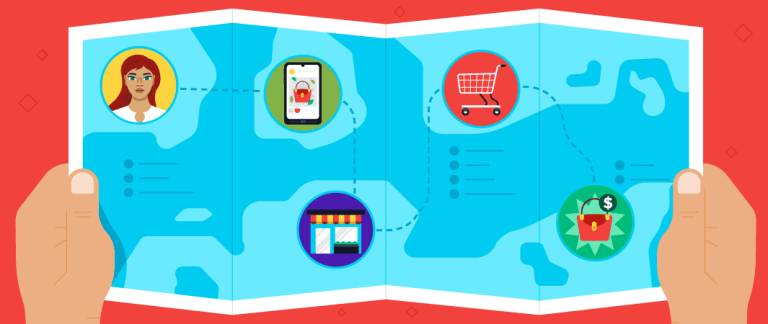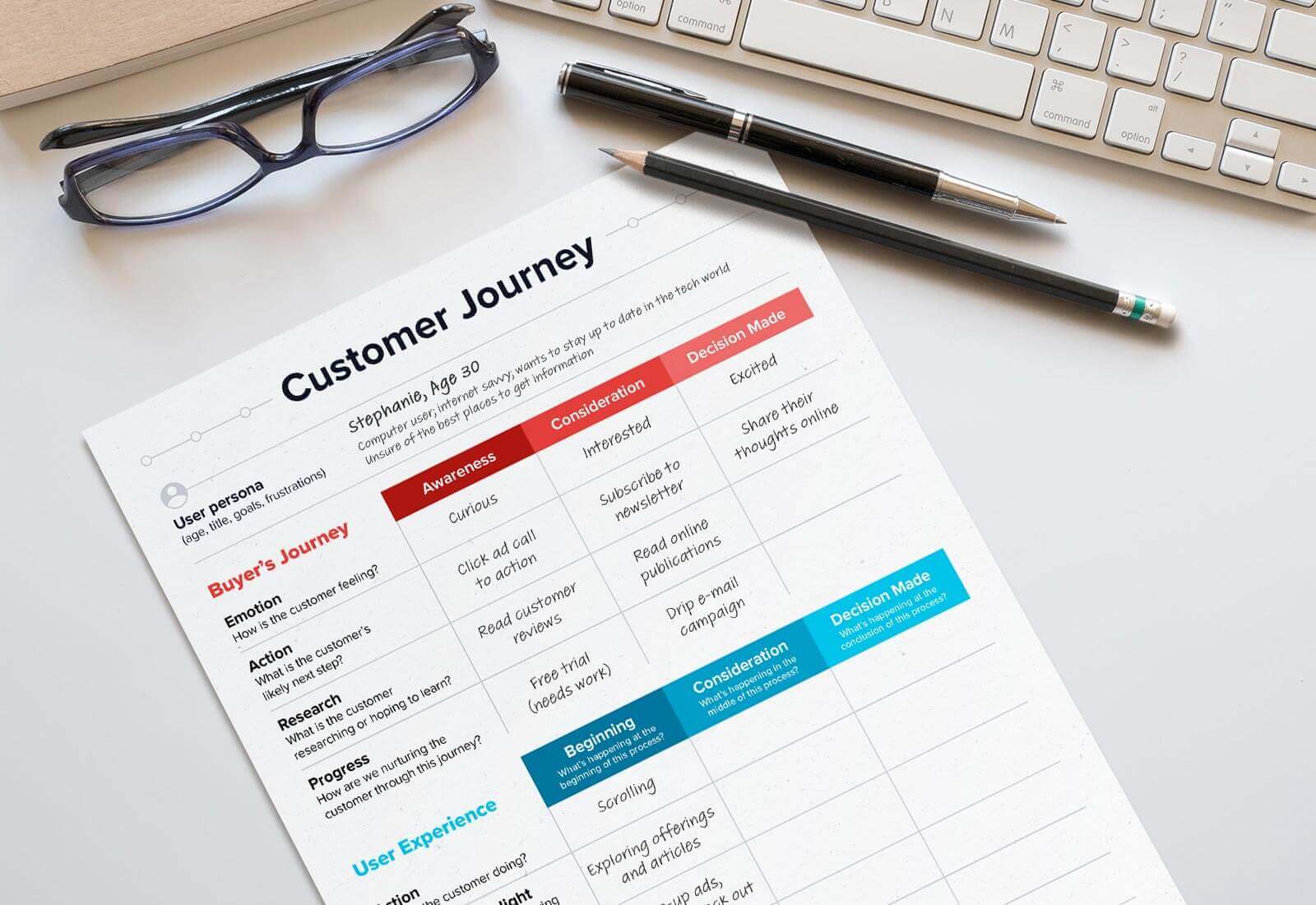Learn how you can Unlock Limitless Customer Lifetime Value with CleverTap’s All-in-One Customer Engagement Platform.

Wouldn’t it be great if customers recognized your product’s value proposition from the moment they first experienced your brand? Alas, that’s not the world we live in. These days, when so many things compete for your customer’s or prospect’s time and attention, customer journey mapping is a must.
Let’s explore the what, why, and how of customer journey mapping. We’ll also share a customer journey map template for mobile marketers to get you started.
Table of Contents

Customer journey mapping is a way to empathize with, and understand, your customer through a structured and strategic process.
When you create a customer journey map, you make a visual outline of the thought processes, steps, and experiences your prospect or customer goes through as they interact with your app, website, or product.
The purpose of a customer journey map is to get a better understanding of things like:
The main goal of a customer journey map is to form a better understanding of how your customer experiences your brand and its products and services. But it goes beyond that.
When you create a visual outline of your customer’s journey across different channels and touchpoints, that roadmap informs your brand strategy in a way that ultimately levels up your customer experience.

Customer journey mapping is an essential step in optimizing your customer or user experience. It allows you to form strategies based on your customer’s expectations.
Before we share a customer journey template to help you get started on the process, let’s take a closer look at some of the benefits of customer journey mapping.
Are your business goals aligned with your customer’s goals? If you don’t understand your customer’s perspectives, needs, and pain points, you won’t be able to meet them in a way that builds loyalty. Customer journey mapping challenges you to empathize with your customer so you can deliver an experience that matches their expectations.
Your customers experience your brand across multiple channels: advertising, marketing, sales, and customer service, to name a few. They may interact with your website, but also with your app or social media accounts. Journey mapping helps your team ensure that all of those channels work collaboratively to create a seamless user experience.
Read our guide to omnichannel marketing to learn more.
Without a customer journey map, you’re flying blind. That’s why investing time in understanding and empathizing with the people who use your products and services is the surest path to customer engagement, conversion, and retention.
Customer journey mapping can help you uncover anything that might be hurting retention. By reviewing customer behavioral analytics, you can find points of frustration, like a too-slow website or a confusing app interface, and remedy them to improve customer experience.

Now that you’re sold on the value of building customer journey maps to guide your lifecycle marketing and business strategy, let’s take a closer look at how to create a customer journey map, step by step.
Where do your business goals and your customers’ needs align? That’s the magical sweet spot you need to optimize for. Begin the customer journey mapping process by finding that meeting point and writing it down.
Now, let’s humanize your users by creating user personas. After all, the customers using your product or service are real people with real needs and problems. User personas are semi-fictitious characters that represent your target customers. You create these personas by using real customer behavior intel and researching the needs and goals of people who interact with your brand.
Check out our guide to creating user personas for inspiration.
Now it’s time to take note of the important places on your website or in your app where your customers interact with your brand. For example, an e-commerce site might trace the touchpoints that lead a potential buyer from their product pages to their shopping cart to checkout. It might look something like this:
We’ve simplified this, but you may have other steps — an abandoned shopping cart email or shipment delivery notification, for example — along the way.
Pro Tip: Don’t get bogged down in the details. It’s not necessary to include every little detail. Focus on the big moments that get you closest to your business goals.
Touchpoints are like milestones. They’re the significant markers your customers reach on their journey. Actions are the steps that get them from one touchpoint to another.
Here’s an example. If your customer reaches your landing page, what actions will they take to get them to an individual product page? Those actions could be something like clicking on a specific product category or performing a search for an item by name.
Pro Tip: Listing actions can help you identify points in the customer journey where your customers have to take multiple steps to get from one objective to another. Can you find areas where you can simplify and reduce the number of steps it takes for a customer to reach the next milestone?
Now, take the customer journey yourself. Look for potential pain points. Is a page loading too slowly? Is something hard to find in your app interface? Where might your customer encounter an obstacle that results in a negative experience?
Don’t forget to make note of potential moments of surprise and delight. Maybe your customer was drawn to your brand by a fun social media campaign. That’s a win!
Once you’ve made note of the highs and lows, you can examine them for opportunities. Maybe customers who were enticed by your brand on social media became frustrated when they landed on your mobile website because it loaded too slowly.
Bingo! You’ve found a roadblock on your customer’s journey. Remove the obstacle, and you’ll improve the customer experience.
At each point of interaction, consider and note the emotional state your user might be in. Use your analytics tools to analyze your customers’ behavior and make an educated guess about their emotional response.
Maybe a behavioral analytics tool showed you that your customers tend to drop off when they encounter a pop-up. It doesn’t take much thought to come to the conclusion that your customer felt annoyed. Or maybe you’ve discovered that a high percentage of your users have taken you up on your free download — that’s a moment of delight.
Now that you’ve gathered information, you’re ready to create your customer journey map. Create a visual representation of the data you’ve gathered as you complete these steps. You can start simply with a customer journey template if you prefer, or develop a map through a more robust process.
Some marketing analytics software such as CMSes and engagement and retention suites like CleverTap already include customer journey mapping tools. These tools allow you to use data to construct your campaigns easily on a visual canvas.
Your customer journey map could be as simple as a freehand drawing or even a bunch of sticky notes stuck to a wall. But while there’s nothing wrong with a lo-fi approach, the better your customer journey map, the easier it will be to share it with your team so everyone’s on board as you hone your marketing strategy.
If you’d like to step up your customer journey mapping process, there are a number of free and paid design tools available, including:
CleverTap’s customer engagement and retention platform includes Journeys, a visual campaign builder that allows you to:

If you’re inspired to create a map of your own, this downloadable customer journey map template will get you started. Print the template for some old-school brainstorming or use the fillable PDF to create a document you can easily share with your team.
Remember that a good customer journey map example is one that is comprehensive, leaving no stone unturned. Be sure to cover every possible touchpoint with your brand.
There’s no better path to engaging and retaining your customers than understanding who they are, how they feel, and what problems they hope to solve.
Through the structured process of customer journey mapping, you’ll uncover your own roadmap to guide you through UX improvements that will reduce customer churn and increase conversions.

See how today’s top brands use CleverTap to drive long-term growth and retention